The helmet communication issue highlights college football’s struggles to replicate NFL systems
Helmet communication systems have now emerged as the latest example of how college football is trying—and failing—to adopt elements from the NFL.
Perhaps it could work — if only we had a clear understanding of our actions.
“At times, it feels like we’re hastily trying to fix problems with nothing but good intentions,” stated LSU coach Brian Kelly in July regarding the chaotic approach of mirroring the NFL’s practices in college football.
The most recent blunder (and I can’t believe I’m saying this): college football has chosen to adopt the NFL’s helmet communication system—yet without any form of signal encryption. As ridiculous as that may seem, it ought not to be unexpected.
It’s a shocking revelation.
We are familiar with this scenario and its outcome.
There’s a clear distinction between college football and the NFL, despite efforts from university leaders, conference heads, coaches, and players to make them comparable.
The SEC and Big Ten do not equate to the NFC and AFC. Likewise, the College Football Playoff is not equivalent to the NFL playoffs.
Recruiting
What happens in college football is not the same as the NFL draft, and player mobility is not equivalent to free agency while pay-for-play arrangements differ from salary cap rules.
The NFL operates as a multi-billion dollar entity, employing extensive research and contingency plans to safeguard its status as one of the most successful sports leagues globally against external pressures.
In contrast, college football functions as a vast collection of small businesses that publicly unite for common interests but often work discreetly to distinguish themselves from one another.
The NFL operates like a straight path with a clear entrance and exit.
In contrast, college football resembles a complicated maze filled with uncertainty and frustration, characterized by constantly changing barriers that shift every season. It’s an unpredictable blend of organized chaos.
This leads us back to the most recent instance where college football struggled to emulate the NFL. Thirty years ago, the NFL adopted helmet communications technology, moving away from traditional signals and the hassle of substituting players for play calls.
Is this situation ringing any bells for you?
YSL News Sports” caption=”Texas Tech coach Joey McGuire, left, observes the action during the first half of his team’s match against Abilene Christian at Jones AT&T Stadium and Cody Campbell Field.” orientation=horizontal class=spacer-large util-module-path=elements/media>
Recently, the NCAA rules committee simplified the helmet communication process. However, this change has quickly turned into a complicated issue filled with accusations and theories. Texas Tech has requested that the Big 12 investigate their games against TCU and Baylor (both of which they lost) to ensure everything is in order.
To overcome their rivals, some teams resort to unorthodox methods.
This controversy arises just a few months after the reigning national champion, Michigan, faced issues with a former staff member who was caught scouting future teams and recording their signals. You might expect that, considering the previous head coach of the champions received a three-game suspension from his conference due to this sign-stealing scandal, college football would approach helmet communication with caution—especially without adopting the exact model used by the NFL (and yes, that’s sarcasm).
The precise model and procedure.
However, rather than meticulously replicating this system—including crucial device encryption—
College football has taken a significant step by encouraging open communication, and now Texas Tech is quietly raising questions about how they ended up losing to Baylor by 24 points. I assure you, this is not a fabrication.
Naturally, this situation invites wild conspiracy theories suggesting that someone in the stadium might be using a scanner to eavesdrop on sideline conversations, thereby giving one team an unfair advantage.
As a result, the Power Four conferences have returned the devices to their manufacturers, who will now implement software updates that feature encryption. These updated devices will be ready in time for Saturday’s games.
It’s quite amusing.
Observing this situation from afar, I contacted a coach from one of the Power Four teams on Wednesday night. He was visibly frustrated while describing the excessive response to yet another sign-stealing incident and eventually suggested that focusing on fundamental skills like blocking and tackling might be a more effective approach.
Imagine if someone in the stadium had a scanner capable of tuning into the right channel.
Even with most stadiums equipped with Wi-Fi and thousands of cell phones packed into a small area, sometimes ranging from 65,000 to 105,000 people, the enthusiasm of the crowd can vary.
The individual will need to locate the right channel where the audio is clear and comprehensible without any disruptions. After that initial step, they face a more complex task: deciphering the team’s play calling language.
Due to headsets automatically cutting off at 15 seconds on the play clock, the person using a scanner remains unaffected by all that Wi-Fi interference.
Signals and mobile phones are often used closely together, which requires translating complex terminology into simpler football language. Then, they need to switch to their team’s communication channel and relay the play call.
At this point, the coaching staff on the sidelines must analyze whether it’s a defensive or offensive strategy from the opponent, determine necessary adjustments, and communicate any changes in play calls to the players on the field.
All of this happens within a mere 15 seconds.
This is likely why college football struggles with establishing NIL guidelines, managing player transfers, determining pay structures for players, coordinating non-conference schedules, and tackling many other challenges in the sport as it evolves.
In the realm of the NFL model, simplicity reigns supreme. It all boils down to essential skills like blocking and tackling.
This approach captures a certain beauty in its imperfections.

